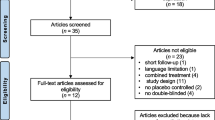Abstract
Atypical antipsychotics may be useful in chronic pain treatment. The objective of the present study was to assess the effect of ziprasidone in fibromyalgia management. Ziprasidone was administered to 32 fibromyalgia patients at a dose of 20 mg/day, subsequently adjusted according to clinical response and tolerability. Fibromyalgia Impact Questionnaire (FIQ), Pittsburgh Sleep Quality Index (PSQI), a Clinical Global Impression improvement scale (CGIi), and a scale evaluating the severity of fibromyalgia symptoms were administered at 4 week intervals for 12 weeks. Drug adverse reactions were recorded. Ten patients withdrew from the study. The CGIi showed 32% of responders. FIQ and PSQI scores showed a non-statistically significant decrease. The conditions of stiffness, anxiety and sadness improved significantly. Most frequent side effects included sleep disturbances, headache, tremor, and rigidity. Although ziprasidone does not seem an especially useful adjunct drug in fibromyalgia, it could be tried on patients who are markedly anxious and/or depressed.

Similar content being viewed by others
References
Wolfe F, Smythe HA, Yunus MB, Bennett RM, Bombardier C, Goldenberg DL, et al (1990) The American College of Rheumatology 1990 criteria for the classification of fibromyalgia: report of the multicenter criteria committee. Arthritis Rheum 1990 33:160–172
Crofford LJ (2004) Pharmaceutical treatment options for fibromyalgia. Curr Rheumatol Rep 6:274–280
Staud R, Domingo MA (2001) Evidence for abnormal pain processing in fibromyalgia syndrome. Pain Med 2:208–215
Pridmore S, Samilowitz H, Oberoi G (2003) Will the atypical antipsychotics be analgesics? Australas Psychiatry 11:59–61
Fishbain DA, Cutler RB, Lewis J, Cole B, Rosomoff RS, Rosomoff HL (2004) Do the second-generation atypical neuroleptics@ have analgesic properties? A structured evidence-based review. Pain Med 5:359–365
Kiser RS, Cohen HM, Freedenfeld RN, Jewell C, Fuchs PN (2001) Olanzapine for the treatment of fibromyalgia symptoms. J Pain Symptom Manage 22:704–708
Rico-Villademoros F, Hidalgo J, Dominguez I, García-Leiva JM, Calandre EP (2005) Atypical antipsychotics in the treatment of fibromyalgia: a case series with olanzapine. Progr Neuropsychopharmacol Biol Psychiatry 29:161–164
Shemo M, Shemo JPD, Anderson M (2003) Beneficial effects of quetiapine treatment in patients with fibromyalgia. J Neuropsychiatry Clin Neurosci 15:282 (abstract)
Calandre EP, Hidalgo J, Rico-Villademoros F, Rodriguez V (2005) Evaluation of quetiapine as coadjuvant drug in fibromyalgia management. Eur J Neuropsychopharmacol 15(suppl 2): S458 (abstract)
Stahl SM, Shayegan DK (2003) The psychopharmacology of ziprasidone: receptor-binding properties and real-world psychiatric practice. J Clin Psychiatry 64(suppl 9):6–12
Wilner KD, Anziano RJ, Johnson AC, Miceli JJ, Fricke JR, Titus CK (2002) The anxiolytic effects of the novel antipsychotic ziprasidone compared with diazepam in subjects anxious before dental surgery. J Clin Psychopharmacol 22:206–210
Bradley LA (2005) Psychiatric comorbidity in fibromyalgia. Curr Pain Headache Rep 9:79–86
Burckhardt CS, Clark SR, Bennett RM (1991) The fibromyalgia impact questionnaire: development and validation. J Rheumatol 18:728–733
Guy W (1976) ECDEU assessment manual for psychopharmacology, revised (DHEW Publ No ADM 76–338). Department of Health, Education, and Welfare, Public Health Service, Alcohol, Drug abuse, and Mental health administration, NIMH Psychopharmacology Research Branch, Division of Extramural Research Programs, Rockville, pp 218–222
Buysse DJ, Reynolds CF 3rd, Monk TH, Berman SR, Kupfer DJ (1989) The Pittsburgh sleep quality index: a new instrument for psychiatric practice and research. Psychiatry Res 28:193–213
Acknowledgments
The authors want to thank Ms Violeta Rodriguez and Mr Juan Salvador Vilchez for their technical assistance with the evaluation of the scales.
Funding and disclosure: The authors state that this research has not received any funding and that none of them has any conflict of interest.
Author information
Authors and Affiliations
Corresponding author
Rights and permissions
About this article
Cite this article
Calandre, E.P., Hidalgo, J. & Rico-Villademoros, F. Use of ziprasidone in patients with fibromyalgia: a case series. Rheumatol Int 27, 473–476 (2007). https://doi.org/10.1007/s00296-006-0243-z
Received:
Accepted:
Published:
Issue Date:
DOI: https://doi.org/10.1007/s00296-006-0243-z




